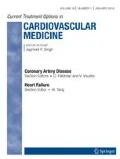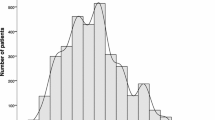Abstract
Purpose of review
This review explores key features and potential management controversies in two emerging populations in heart failure: heart failure with recovered ejection fraction (HF-recovered EF) and heart failure with mid-range ejection fraction (HFmrEF).
Recent findings
While HF-recovered EF patients have better outcomes than heart failure with reduced ejection fraction (HFrEF), they continue to have symptoms, persistent biomarker elevations, and abnormal outcomes suggesting a continued disease process. HFmrEF patients appear to have features of HFrEF and heart failure with preserved ejection fraction (HFpEF), but have a high prevalence of ischemic heart disease and may represent a transitory phase between the HFrEF and HFpEF. Management strategies have insufficient data to warrant standardization at this time.
Summary
HF-recovered EF and HFmrEF represent new populations with unmet needs and expose the pitfalls of an EF basis for heart failure classification.

Similar content being viewed by others
References and Recommended Reading
Papers of particular interest, published recently, have been highlighted as: • Of importance •• Of major importance
Yancy C, Jessup M, Bozkurt B, Butler J, Casey D Jr, Drazner M, et al. 2013 ACCF/AHA guideline for the management of heart failure: a report of the American College of Cardiology Foundation/American Heart Association Task Force on Practice Guidelines. Circulation. 2013;128:e240–327.
• Punnoose L, Givertz M, Lewis E, Pratibhu P, Stevenson L, Desai A. Heart failure with recovered ejection fraction: a distinct clinical entity. J Card Fail. 2011;17(7):527–32. This paper was the first to describe HF-Recovered EF out of a group of patients who were labeled as HFpEF, suggesting that HFrEF patients who improve ejection fraction are a distinct population.
• Basuray A, French B, Ky B, Vorovich E, Olt C, Sweitzer N, et al. Heart failure with recovered ejection fraction: clinical description, biomarkers and outcomes. Circulation. 2014;129(23):2380–7. This paper was the first to demonstrate that despite a normalized LVEF, patients with a recovered EF were not normal as demonstrated by clinical charactersitics, biomarkers, and outcomes.
Ponikowski P, Voors A, Anker S, Bueno H, Cleland J, Coats A, et al. 2016 ESC guidelines for the diagnosis and treatment of acute and chronic heart failure: The Task Force for the diagnosis and treatment of acute and chronic heart failure of the European Society of Cardiology (ESC). Eur Heart J. 2016;37:2129–200.
Cohn J, Ferrari R, Sharpe N. Cardiac remodeling—concepts and clinical implications: a concensus paper from an international forum on cardiac remodeling. Behalf of an international forum on Cardiac remodeling. J Am Coll Cardiol. 2000;35(3):569–82.
Merlo M, Stolfo D, Anzini M, Negri F, Pinamonti B, Barbati G, et al. Persistent recovery of normal left ventricular function and dimension in idiopathic dilated cardiomyopathy during long-term follow-up: does real healing exist? J Am Heart Assoc. 2015;4(1).
Kubanek M, Sramko M, Maluskova J, Kautznerova D, Weichet J, Lupinek P, et al. Novel predictors of left ventricular reverse remodeling in individuals with recent-onset dilated cardiomyopathy. J Am Coll Cardiol. 2013;61:54–63.
Semigran M, Thaik C, Fifer M, Boucher C, Palacios I, Dec G. Exercise capacity and systolic and diastolic ventricular function after recovery from acute dilated cardiomyopathy. J Am Coll Cardiol. 1994;24(2):462–70.
Zecchin M, Proclemer A, Magnani S, Vitali-Serdoz L, Facchin D, Muser D, et al. Long-term outcome of ‘super-responder’ patients to cardiac resynchronization therapy. Europace. 2014;16:363–71.
de Groote P, Fertin M, Pentiah A, Goeminne C, Lamblin N, Bauters C. Long-term functional and clinical follow-up of patients with heart failure with recovered left ventricular ejection fraction after beta-blocker therapy. Circ Heart Fail. 2014;7:434–9.
Moon J, Ko YG, Chung N, et al. Recovery and recurrance of left ventricular systolic dysfunction in patients with idiopathic dilated cardiomyopathy. Can J Cardiol. 2009;25:e147–50.
Adamo L, Perry A, Novak E, Makan M, Lindman B, Mann D. Abnormal global longitudinal strain predicts future deterioration of left ventricular function in heart failure patients with a recovered left ventricular ejection fraction. Circ Heart Fail. 2017;10(6):e003788.
•• Mann D, Barger P, Burkhoff D. Myocardial recovery and the failing heart: myth, magic, or molecular target? J Am Coll Cardiol. 2012;60(24):2465–72. Excellent explanation of existing data and propositions for future studies on the mechanism of myocardial recovery. It is also a comprehensive review of the myocardial recovery literature.
Drakos S, Kfoury A, Stehlik J, Selzman C, Reid B, Terrovitis J, et al. Bride to recovery, understanding the disconnect between clinical and biological outcomes. Circulation. 2012;126(2):230–41.
Frazier O, Benedict C, Radovancevic B, Bick R, Capek P, Springer W, et al. Improved left ventricular function after chronic left ventricular unloading. Ann Thorac Surg. 1996;62(3):675–81.
Ahmad T, Wang T, O’Brien E, Samsky M, Pura J, Lokhnygina Y, et al. Effects of left ventricular assist device support on biomarkers of cardiovascular stress, fibrosis, fluid homeostasis, inflammation, and renal injury. JACC Heart Fail. 2015;3(1):30–9.
Felker G, Anstrom K, Adams K, Ezekowitz J, Fiuzat M, Houston-Miller N, et al. Effect of natriuretic peptide–guided therapy on hospitalization or cardiovascular mortality in high risk patients with heart failure and reduced ejection fraction: a randomized clinical trial. JAMA. 2017;318(8):713–20.
Birks E, Tansley P, Hardy J, George R, Bowles C, Burke M, et al. Left ventricular assist device and drug therapy for the reversal of heart failure. NEJM. 2006;355(18):1873–84.
• Birks E, George R, Hedger M, Bahrami T, Wilton P, Bowles C, et al. Reversal of severe heart failure with a continuous-flow left ventricular assist device and pharmacological therapy: a prospective study. Circulation. 2011;123(4):381–90. LVAD data showing that myocardial recovery leading to LVAD explantation can be achieved with proper patient selection and intense medical management.
Kirklin J, Pagani F, Kormos R, Stevenson L, Blume E, Myers S, et al. Eigth annual INTERMACS report: Special focus on framing the impact of adverse events. J Heart Lung Tranplant. 2014;36(10):1080–6.
Basuray A, Fang J. Management of patients with recovered systolic function. Prog Cardiovasc Dis. 2015;58(4):434–43.
•• Shah K, Xu H, Matsouaka R, Bhatt D, Heidenreich P, Hernandez A, et al. Heart failure with preserved, borderline, and reduced ejection fraction 5-year outcomes. J Am Coll Cardiol. 2017;70(20):2476–86. This article was pertinent because it used a large cohort to demonstrate that mortality after a HF hospitalization was uniformly associated with poor event-free survival regardless of EF.
Vedin O, Lam C, Koh A, Benson L, Teng T, Tay W, et al. Significance of ischemic heart disease in patients with heart failure and preserved, midrange, and reduced ejection fraction: a nationwide cohort study. Circ Heart Fail. 2017;10(6):e003875.
Chioncel O, Lainscak M, Seferovic P, Anker S, Crespo-Leiro M, Harjola V, et al. Epidemiology and one-year outcomes in patients with chronic heart failure and preserved, mid-range and reduced ejection fraction: an analysis of the ESC Heart Failure Long-Term Registry. Eur J Heart Fail. 2017;19:1574–85.
Rickenbacher P, Kaufmann B, Maeder M, Bernheim A, Goetschalckx K, Pfister O, et al. Heart failure with mid-range ejection fraction: a distinct clinical entity? Insights from the Trial of Intensified versus standard medical therapy in elderly patients with congestive heart failure (TIME-CHF). Eur J Heart Fail. 2017;19:1586–96.
Kapoor J, Kapoor R, Ju C, Heidenreich P, Eapen Z, Hernandez A, et al. Precipitating clinical factors, heart failure characterization, and outcomes in patients hospitalized with heart failure with reduced, borderline, and preserved ejection fraction. JACC Heart Fail. 2016;4(6):464–72.
Sartipy U, Dahlström U, Fu M, Lund L. Atrial fibrillation in heart failure with preserved, mid-range, and reduced ejection fraction. JACC: Heart Fail. 2017;5:565–74.
Sato T, Yoshihisa A, Kanno Y, Suzuki S, Yamaki T, Sugimoto K, et al. Cardiopulmonary exercise testing as prognostic indicators: comparisons among heart failure patients with reduced, mid-range and preserved ejection fraction. Eur J Prev Cardiol. 2017;24(18):1979–87.
• Nadruz W, West E, Santos M, Skali H, Groarke J, Forman D, et al. Heart failure and midrange ejection fraction implications of recovered ejection fraction for exercise tolerance and outcomes. Circ: Heart Fail. 2016;9(4):e002826. First study to suggest HFmrEF group is heterogeneous and that those who recovered from HFrEF have a more favorable phenotype.
Tromp J, Khan M, Mentz R, O’Connor C, Metra M, Dittrich H, et al. Biomarker profiles of acute heart failure patients with a mid-range ejection fraction. JACC: Heart Fail. 2017;5(7):507–17.
Rastogi A, Novak E, Platts A, Mann D. Epidemiology, pathophysiology and clinical outcomes for heart failure patients with a mid-range ejection fraction. Eur J Heart Fail. 2017;19:1597–605.
Tsuji K, Sakata Y, Nochioka K, Miura M, Yamauchi T, Onose T, et al. Characterization of heart failure patients with mid-range left ventricular ejection fraction—a report from the CHART-2 Study. Eur J Heart Fail. 2017;19:1258–69.
Lam C, Solomon S. Fussing over the middle child. Circulation. 2017;135:1279–80.
Dunlay S, Roger V, Weston S, Jiang R, Redfield M. Longitudinal changes in ejection fraction in heart failure patients with preserved and reduced ejection fraction. Circ Heart Fail. 2012;5(6):720–6.
Paulus W, Tschope C. A novel paradigm for heart failure with preserved ejection fraction: comorbidities drive myocardial dysfunction and remodeling through coronary microvascular endothelial inflammation. J Am Coll Cardiol. 2013;62(4):263–71.
Florea V, Rector T, Anand I, Cohn J. Heart failure with improved ejection fraction: clinical characteristics, correlates of recovery, and survival results from the Valsartan Heart Failure Trial. Circ Heart Fail. 2016;9(7):e003123.
Hsu J, Boback Z, Fonarow G. Heart failure with mid-range (borderline) ejection fraction clinical implications and future directions. JACC: Heart Fail. 2017;5:763–71.
Vaduganathan M, Patel R, Michel A, Shah S, Senni M, Gheoghiade M. Mode of death in heart failure with preserved ejection fraction. J Am Coll Cardiol. 2017;69(5):556–69.
Solomon S, Claggett B, Lewis E, Desai A, Anand I, Sweitzer N, et al. Influence of ejection fraction on outcomes and efficacy of spironolactone in patients with heart failure with preserved ejection fraction. Eur Heart J. 2016;37(5):455–62.
Cleland J, Bunting K, Flather M, Altman D, Holmes J, Coats A, et al. Beta-blockers for heart failure with reduced, mid-range, and preserved ejection fraction: an individual patient-level analysis of double-blind randomized trials. Eur Heart J. 2018;39(1):26–35.
Kotecha D, Flather M, Altman D, Holmes J, Rosano G, Wikstrand J, et al. Heart rate and rhythm and the benefit of beta-blockers in patients with heart failure. J Am Coll Cardiol. 2017;69(24):2885–96.
Savarese G, Donal E, Hage C, Oger E, Persson H, Daubert J, et al. Changes in natriuretic peptides after acute hospital presentation for heart failure with preserved ejection fraction: a feasible surrogate trial endpoint? A report from the prospective Karen study. Int J Cardiol. 2017;226:65–70.
Kutyifa V, Beck C, Brown M, Cannom D, Daubert J, Estes M, et al. Multicenter automatic defibrillator implantation trial-subcutaneous implantable cardioverter defibrillator (MADIT S-ICD); design and clinical protocol. Am Heart J. 2017;189:158–66.
Stevenson L. Heart failure better EF: a modern diagnosis. Circulation. 2014;129:2364–7.
Packer M. Heart failure with a mid-range ejection fraction: a disorder that a psychiatrist would love. JACC: Heart Fail. 2017;5(11):805–7.
Author information
Authors and Affiliations
Ethics declarations
Conflict of Interest
Peter Unkovic and Anupam Basuray each declare no potential conflicts of interest.
Human and Animal Rights and Informed Consent
This article does not contain any studies with human or animal subjects performed by any of the authors.
Additional information
This article is part of the Topical Collection on Heart Failure
Rights and permissions
About this article
Cite this article
Unkovic, P., Basuray, A. Heart Failure with Recovered EF and Heart Failure with Mid-Range EF: Current Recommendations and Controversies. Curr Treat Options Cardio Med 20, 35 (2018). https://doi.org/10.1007/s11936-018-0628-9
Published:
DOI: https://doi.org/10.1007/s11936-018-0628-9



